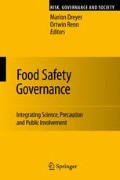In a thorough review of risk communication, William Leiss identified three phases in the evolution of risk communication practices (Leiss 1996: 85ff). The first phase of risk communication emphasized the necessity of conveying probabilistic thinking to the general public and to educate the laypersons to acknowledge and accept the risk management practices of the respective institutions. The most prominent instrument of risk communication in phase 1 was the application of risk comparisons. If anyone was willing to accept x fatalities as a result of voluntary activities, they should be obliged to accept another voluntary activity with less than x fatalities. However, this logic failed to convince audiences: people were unwilling to abstract from the context of risk-taking and the corresponding social conditions, and they also rejected the reliance on expected values as the only benchmarks for evaluating risks.
Access this chapter
Tax calculation will be finalised at checkout
Purchases are for personal use only
Notes
- 1.
1 There are two important points to make at the outset of the present chapter. First, throughout this chapter the term risk communication is used in a broad meaning to denote all types of communication about food safety threats. In our conceptual framework the term “risk” is defined in a strict sense, as referring to a situation where both the magnitudes of and the probabilities for a defined range of outcomes can be confidently quantified (see Sect. 1.1). In the present chapter, however, we have adopted the usual meaning of risk communication as a generic term to include any exchange of information dealing with the uncertain consequences of an event or an activity such as eating. In our terminology that will also include communication about uncertain or ambiguous food safety threats. A systematic differentiation between food safety communication (the term which is consistent throughout our overall conceptual framework) and risk communication (the term generally used in the existing body of literature which the chapter extensively refers to) would lead to confusion and would produce inconsistencies with the existing literature on risk communication.
The second point to mention is that this chapter had not been included in the early account of the General Framework which was put up for discussion in the workshop-based feedback and review process (cp. Chap. 11). Nor was it part of the revised version subjected for commenting (Dreyer et al. 2007a). The four invited commentaries (see Chap. 12) therefore do not relate to it. The chapter on risk communication was only added to the present volume, partly because several of the governance actors who provided us with a feedback missed a discussion on this topic and advised us to add a section on risk communication.
- 2.
Cp. Hance et al. (1988); Lundgren (1994); Breakwell (2007: 130ff); Renn (2008: 240ff).
- 3.
Cp. Luhmann (1989, 1993); Jungermann and Wiedemann (1995); IRGC (2005).
- 4.
Cp. Slovic (1987, 1992); Boholm (1998); Rohrmann and Renn (2000); Sjöberg (2000); Breakwell (2007); Renn (2008: 98ff).
- 5.
For overviews on the subject, see Chess et al. (1989); Covello et al. (1989); Leiss (1989); US National Research Council (1989); Atman et al. (1994); Morgan et al. (2001); Lundgren (1994); Gutteling and Wiegman (1996); UK Inter-Departmental Liaison Group on Risk Assessment (1998); Covello and Sandman (2001); Löfstedt (2001); OECD (2002); Drottz-Sjöberg (2003); STARC (2006); Breakwell (2007: 130ff); Renn (2008: 199ff).
- 6.
See Kasperson (1986: 275); Plough and Krimsky (1987); Luhmann (1990); Jasanoff (1993); Fischhoff (1995); Leiss (1996).
- 7.
See e.g. Covello et al. (1986: 172); Zimmerman (1987: 131ff); Kasperson and Palmlund (1988); US National Research Council (1989); Breakwell (2007:155ff).
- 8.
See similar classifications in: Chess et al. (1989); Hance et al. (1988); Morgan et al. (1992, 2001); De Marchi (1995); Mulligan et al. (1998); Sadar and Shull (2000); OECD (2002); Löfstedt (2003); Leiss (2004).
- 9.
For this see the review in Fearn-Banks (1996).
- 10.
For example in the case of listeria, where cheese farmers in southern France do not understand the judgement of food safety agencies to ban cheese produced by non-pasteurized milk (Knight et al. 2008: 209ff).
- 11.
No observable adverse effect level (NOAEL).
- 12.
See Rohrmann (1992, 1995); Bostrom et al. (1994); OECD (2002); Renn et al. (2005); Renn (2008: 318ff).
- 13.
Similar in: Leiss and Chociolco (1994); Jungermann and Wiedemann (1995); Leiss (1996).
Author information
Authors and Affiliations
Corresponding author
Editor information
Editors and Affiliations
Rights and permissions
Copyright information
© 2009 Springer-Verlag Berlin Heidelberg
About this chapter
Cite this chapter
Renn, O. (2009). Communication About Food Safety. In: Renn, O., Dreyer, M. (eds) Food Safety Governance. Risk, Governance and Society, vol 15. Springer, Berlin, Heidelberg. https://doi.org/10.1007/978-3-540-69309-3_9
Download citation
DOI: https://doi.org/10.1007/978-3-540-69309-3_9
Published:
Publisher Name: Springer, Berlin, Heidelberg
Print ISBN: 978-3-540-69308-6
Online ISBN: 978-3-540-69309-3
eBook Packages: Business and EconomicsEconomics and Finance (R0)

